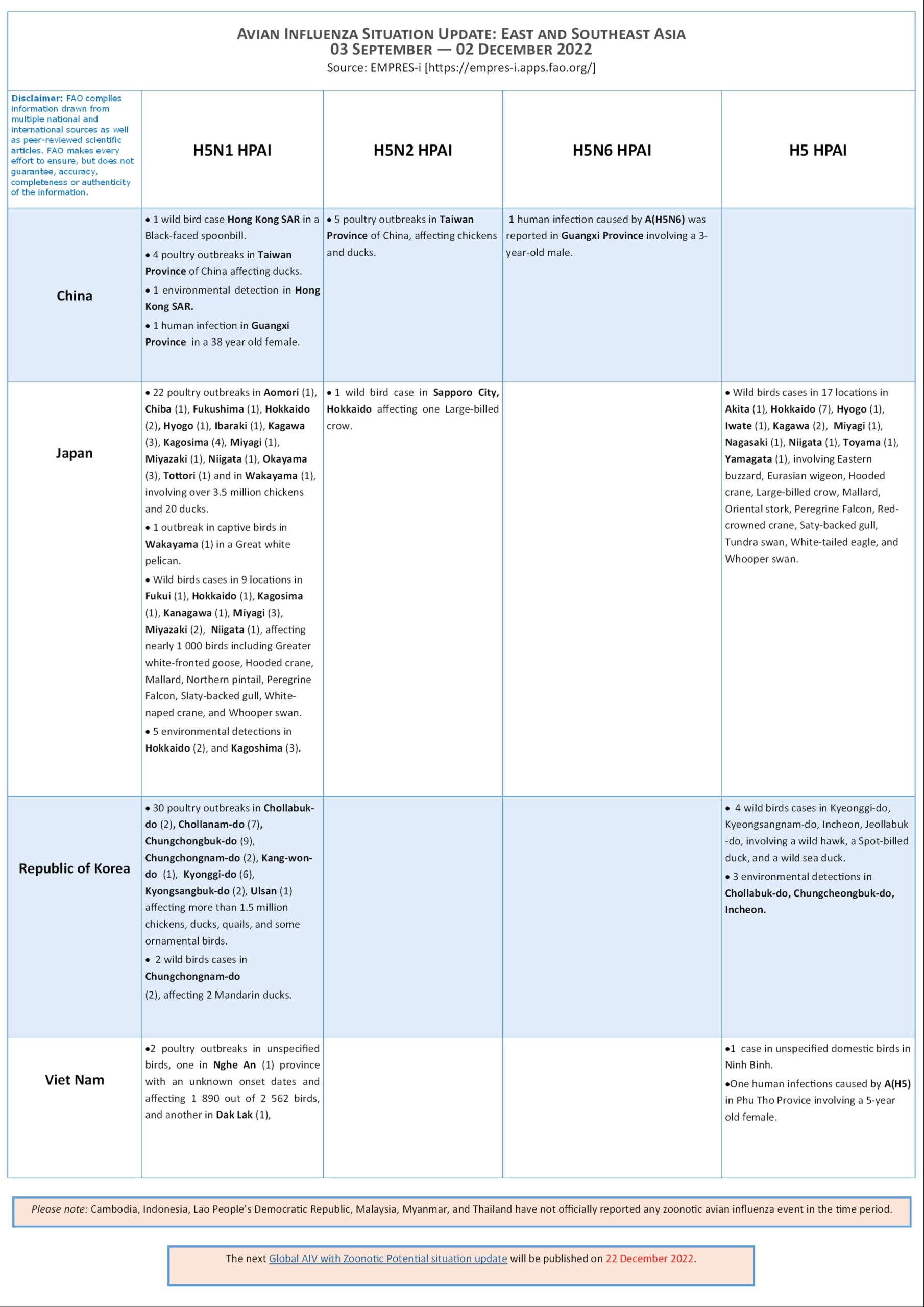FAO/EMPRES-AH is constantly monitoring the avian influenza situation worldwide and compiles information from multiple national and international sources as well as peer-reviewed scientific articles. Close collaboration with country and regional offices, the implementation of avian influenza field surveillance projects, and networks of expertise like WOAH/FAO’s OFFLU (www.offlu.org) provide access to timely information on outbreaks, surveillance findings, and genetic similarities of circulating viruses or their virological features. This information is stored in the EMPRES Global Animal Disease Information System (EMPRES-i), a database that can be accessed online at https://empres-i.apps.fao.org/.

Avian Influenza in East and Southeast Asia from 03 September to 02 December 2022 ©EMPRES-I
During the period of 02 September to 02 December 2022, four highly pathogenic avian influenza (HPAI) virus subtypes (H5, H5N1, H5N2, and H5N6) and one low pathogenic avian influenza (LPAI) virus subtype (H6N2) have been reported in Eastern and South-eastern Asia. H5Nx HPAI viruses continue to circulate in Eastern and South-eastern Asia and detections are significantly increasing in certain areas of these sub-regions. Within the reporting period, Viet Nam officially reported one H5N1 HPAI outbreak in domestic birds in Hoa Thanh affecting 1826 bird, and two outbreaks with unknown onset dates in domestic birds in Dak Lak (H5N1) and Ninh Binh (subtype unconfirmed). Japan have officially reported one detection of H5N2 HPAI in a Large-billed crow (Corvus macrorhynchos), as well as 12 outbreaks of H5N1 in poultry in 6 different administrative regions affecting chickens and unspecified birds. There have also been multiple detections reported in wild birds, the majority of which were in Hooded Cranes (Grus monacha), White-Naped Cranes (Grus vipio), and in other species including Falconidae, Anser, and Corvus species. In China, one H5N1 HPAI detection was reported in Hong Kong SAR, China in an unspecified wild bird. Taiwan Province, China reported one H5N2 HPAI outbreak affecting 60 unspecified domestic birds. Additionally, there was one H5N1 HPAI outbreak in commercial domestic parent stock ducks affecting 5010 birds and one H5N1 detection in a wild duck. During the reporting period, China reported no detections of H5 viruses in wild birds nor poultry, although wild bird surveillance is affected by COVID-19. In the Republic of Korea there have been two reports of H5N1 in captured wild mandarin ducks (Aix galericulata), as well as 20 outbreaks of H5N1 HPAI reported in domestic chicken and duck broilers, laying hens, and common quail. The regions affected include Chollanam-do (Jeollanam-do) (3), Chungchongbuk-do (Chungcheongbuk-do) (7), Chungchongnam-do (Chungcheongnam-do) (1), Kang-won-do (Gangwon-do) (1), Kyonggi-do (Gyeonggi-do) (5), Kyongsangbuk-do (Gyeongsangbuk-do) (2). Over 1 million birds have been destroyed.
In addition to outbreaks in avian species, Viet Nam reported one influenza A(H5) human infection in a 5-year-old female who had exposure to backyard poultry and ducks; the subtype was not able to be confirmed. China reported one influenza A(H5N6) in a 3-year-old male from Guangxi province who owned backyard poultry. Additionally, one case of A(H5N1) was reported in a 38-year-old female farmer from Guangxi province who had exposure to backyard poultry. Since 2014 (as of 2 December 2022), there have been 81 A(H5N6) human infections reported globally, with 80 of them having occurred in Mainland China, the latest case being reported on 28 September 2022. Furthermore, two human infections caused by influenza A(H9N2) were reported in young children in Guangdong and Sichuan provinces, China.
Highly pathogenic H5N1, H5N2, H5N5, H5N6, and H5N8 viruses have demonstrated the ability to spread via migratory water birds and are infecting a broader range of wild bird species than previously seen.
We expect avian influenza activity in Asia to have increased in the period from September to December, and reports of outbreaks in poultry or detections in wild birds and humans are expected to continue to increase in the region over the coming months.






